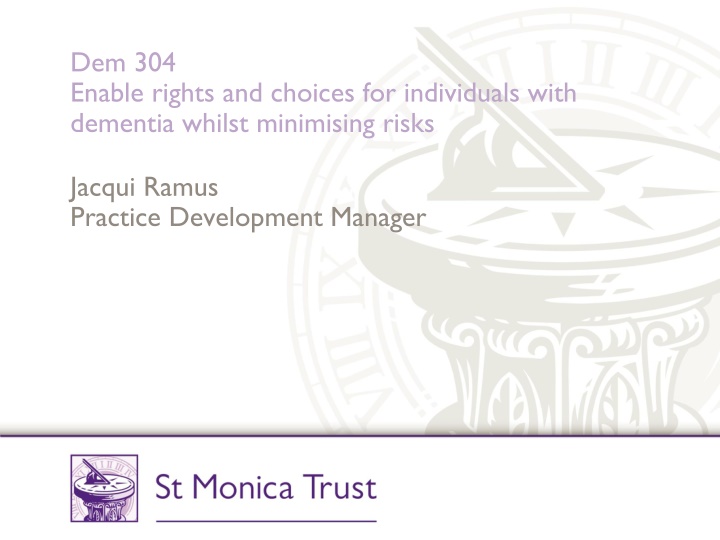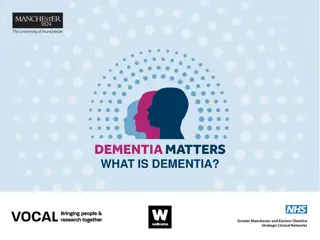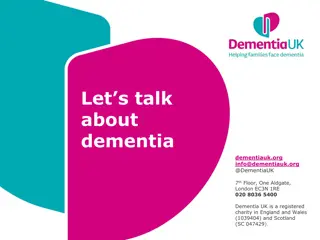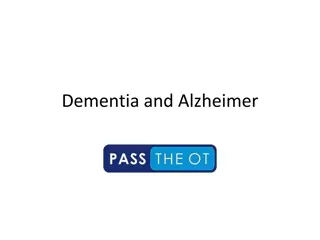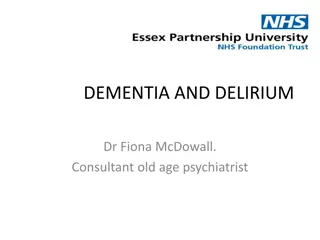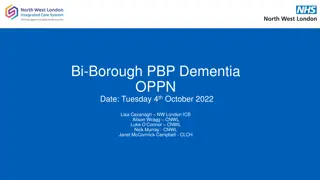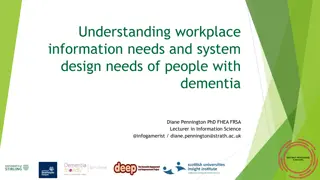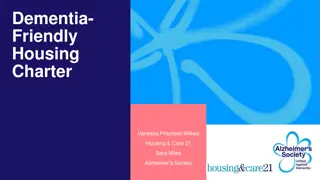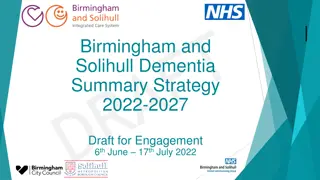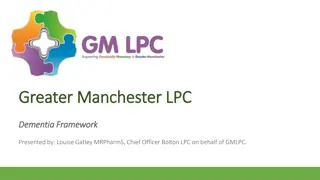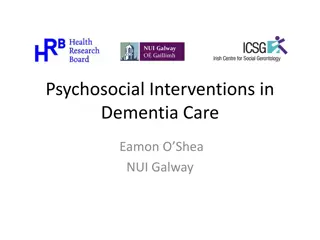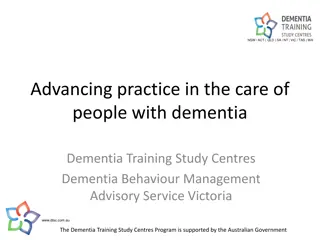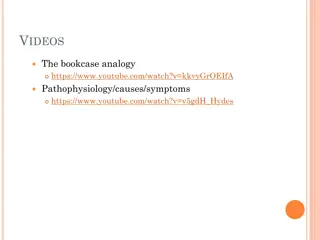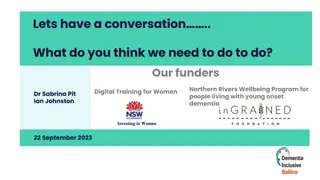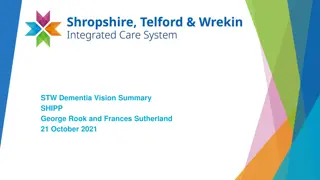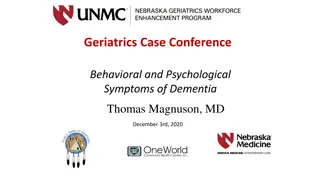Empowering Dementia Individuals: Rights and Choices
Providing insights into enabling rights and choices for individuals with dementia, this content focuses on minimizing associated risks. Exploring practical strategies and approaches, this resource aims to enhance overall quality of life and autonomy for those affected by dementia.
Download Presentation

Please find below an Image/Link to download the presentation.
The content on the website is provided AS IS for your information and personal use only. It may not be sold, licensed, or shared on other websites without obtaining consent from the author.If you encounter any issues during the download, it is possible that the publisher has removed the file from their server.
You are allowed to download the files provided on this website for personal or commercial use, subject to the condition that they are used lawfully. All files are the property of their respective owners.
The content on the website is provided AS IS for your information and personal use only. It may not be sold, licensed, or shared on other websites without obtaining consent from the author.
E N D
Presentation Transcript
Dem 304 Enable rights and choices for individuals with dementia whilst minimising risks Jacqui Ramus Practice Development Manager
Learning outcomes To understand how legislation, policy and procedure affects the way you work with people living with dementia to support their rights and choices, while minimising the risk of harm. To maximise the rights and choices of people living with dementia To involve carers and others in supporting people with dementia. To be able to maintain privacy, dignity and respect of individuals with dementia while promoting rights and choices
Dem 304 Enable rights and choices for individuals with dementia whilst minimising risks THE ROLE OF LEGISLATION IN PROTECTING PEOPLE S RIGHTS Introducing the new identity
Approaches to enable rights and choices for individuals with dementia whilst minimising risks Key legislation: Mental Capacity Act Safeguarding adults Lasting power of attorney Vetting and barring scheme,
Key legislation affecting those living with dementia Mental Capacity Act: Five principles Assume the person has capacity in the first instance Ensure that all practical steps to help person to make a decision have be taken before deciding they lack capacity Do Not treat someone as unable to make a decision because he makes an unwise decision. Make any decisions in the Best Interests of the person concerned Ensure that any preventative action is the least restrictive option
The MCA in practice Ken is 78 and lives at home with his wife, Lucille. Ken s memory is variable (he has dementia) and he has to be reminded to wash and told that he has already eaten. Lucille makes a lot of his day-to-day decisions for him. However, he still goes on his own to his local social club once a week with his neighbour where he meets with friends. Sometimes he loses a lot of money at card sessions at the club. Lucille wonders if she should take control of all his finances to limit his spending. This is causing considerable conflict between them. She asks you about it?( Example from Community Care and Primary Care Training Set, DOH 2007) What could you say? Introducing the new identity
You could: Help Lucille to think that Ken s decision about spending his money at cards is a separate decision which has to be assessed separately from his capacity to make other types of decisions Introducing the new identity
Safeguarding vulnerable adults To empower people To protect people, To prevent possible abuse or neglect To identify proportionate responses to any concerns To encourage partnership and accountability of agencies involved. There are six main reasons for safeguarding policies and procedures
Criminal records (CRB) Criminal Records Bureau checks are designed to bar unsuitable individuals from working with vulnerable groups including children, and in ensuring that organisations can access criminal record information on individuals when the role justifies it.
Independent Safeguarding Authority Employers have a legal duty to refer to the ISA when a person working in regulated activity has harmed a child or adult, or there was a risk of harm (usually following their own disciplinary processes). Anyone barred by the ISA cannot work or volunteer with the group or groups from which they are barred. The ISA makes independent barring decisions following referrals from employers or other organisations and the notification of relevant (automatic barring) offences.
Disclosure and Barring Service (DBS). On 1st December 2012 the Criminal Records Bureau (CRB) and the Independent Safeguarding Authority (ISA) will merge into the Disclosure and Barring Service (DBS). This new organisation will combine the criminal records and barring functions.
Lasting Power of Attorney A Lasting Power of Attorney (LPA) can be used to help plan how a person s health, wellbeing and financial affairs will be looked after. It allows someone to plan in advance: the decisions s/he wants to be made on their behalf if they lose capacity to make them their self the people he/she wants to make these decisions how he/she wants the people to make these decisions it has to be registered with the Office of the Public Guardian before it can be used
Dem 304 Enable rights and choices for individuals with dementia whilst minimising risks MAXIMISING RIGHTS AND CHOICES
Raymonds money The film portrays Raymond, a man in his 80s and recently diagnosed with dementia, and Wendy his paid care worker. The setting is Raymond's flat. Wendy visits daily to provide Raymond with practical support to manage at home. The context of the drama is whether Raymond has capacity to make a decision about spending 50 pounds on lottery tickets. Does Raymond have capacity to ask Wendy to purchase the tickets? Should Wendy be the one to purchase them? What information might need to be shared or recorded with regard to this? What monitoring might there need to be around this situation? Think about the legislation covered earlier. How do you think this applies to Raymond s situation?
Raymonds money Despite Wendy's efforts to engage him in conversation, Raymond remains largely silent until she goes to leave. He then becomes animated about the lottery and asks her to buy 50 pounds worth of lucky dip' tickets. Initially Wendy's response lacks respect for Raymond's request. After further discussion, Wendy decides that Raymond has capacity to make what others might think an unwise decision'. While supporting Raymond to make his own independent decision, Wendy records the decision to comply both with the MCA and good record-keeping practice. The final scenes show Raymond enjoying himself as he checks his tickets against the results.
Risk and rights People with dementia are often seen as more vulnerable to risk than other people but it may be more useful to think about vulnerable situations rather than vulnerable people. Nothing Ventured, Nothing Gained : Risk Guidance for people with dementia, DOH publication 2010
Personal account of living with dementia, Each day brings its own catalogue of risks, some minor and some dangerous. But over time and with forgetting, there is the risk of being put on the side-lines, of being seen as a hindrance, and having control taken away from you, under the guise of it being for your own good. So, while we can, we must challenge the risks People living with a dementia must be allowed to take risks, because if we don t, we are in danger of relaxing into the disease. At times we feel hopeless. At times the hurt we feel is indescribable and we can let it be a barrier to life. But there is a life for us, if we risk it. (Quote: Morgan, 2009, 28 from Nothing Ventured, nothing gained risk guidance for people living with dementia, 2010 DOH publication )
Risk management and best interests decisions take an individualised approach to risk and dementia; find out what each individual knows and understands about the impact that their dementia has - instead of making assumptions about what they know; try to solve problems practically.
Positive risk taking Step 1 Understanding the person s needs. Step 2 Understanding the impact of risks on the person. Step 3 Enabling and managing risk. Step 4 Risk planning. Nothing Ventured, nothing gained risk guidance for people living with dementia, 2010 DOH publication
Justifiable actions to prevent someone from doing something because it is risky should only be taken if : - all reasonable steps have been taken to make the action safe; reliable assessment methods have been used which consider it unsafe; information has been collated and thoroughly evaluated; decisions are recorded, communicated and thoroughly evaluated; policies and procedures have been followed; and practitioners and their managers adopt an investigative approach and are proactive.
In relation to risk taking and best interests decisions:- Understand your own fears and concerns about risk Understand the legislation of safeguarding and mental capacity Identify the real risk level and the benefits of the activity to the person in question
Identifying risk and impact Risk Area What would be the impact if harm happened? How likely is it that any harm would happen? ( H/M/L) To self / others H - Without any intervention it is highly likely that there would be harm How severe would the harm be? ( H/M/L) To self / others A person with dementia who wishes to continue to cook her own meals but has been forgetting to eat. The person could become severely malnourished and ill H - The harm could be severe Source: Nothing Ventured, nothing gained risk guidance for people living with dementia, 2010 DOH publication
Risk and quality of life of one example at issue Contribution to quality of life Risk to individual High relates strongly to top needs Medium delivers value but not much High significant harm is likely Medium likely or significant but not both Low harm neither likely nor significant Low weak contribution to needs Source: Nothing Ventured, nothing gained risk guidance for people living with dementia, 2010 DOH publication Introducing the new identity
HEAT MAP (Nothing Ventured, nothing gained risk guidance for people living with dementia, 2010 DOH publication) Maximise safety to manage risk to protect the individual and manage the activity Carefully balance safety and management to protect the person Some safety improvement necessary High Contribution to quality of life Consider how the same personal benefit can be substituted or delivered in a different way Carefully balance safety improvement and managing the activity to protect the person Improve safety to ensure the activity can be safely carried out Medium The person is at severe risk with little benefit to him/herself Consider the real value of the activity to the individual and seek alternatives that are lower risk, but meet the same needs Allow the activity Low High Medium Low Risk of harm or quality of life to the individual
Practical use Think about someone you work with who might sometimes make unwise decisions, or do things you consider risky How could the identifying risks and impacts table and the Heat Map be used for people that you work with? What role could you have in this? Who else should be involved in identifying risks, and best interests decisions
Dem 304 Enable rights and choices for individuals with dementia whilst minimising risks WORKING WITH OTHERS Introducing the new identity
What information should be shared with others? What do we mean by confidential information? When might it be harmful to share information with relatives, other carers or other professions? When might it be harmful not to share information relatives, other carers or other professions?
Dem 304 Approaches to enable rights and choices for individuals with dementia whilst minimising risks INVOLVING FAMILY AND SIGNIFICANT OTHERS IN DECISION MAKING
Involving others in decision making? Why should family and other significant people be involved in decision making? What conflicts might there be in relation to agreeing risks, promoting rights and choice and agreeing solutions?
Managing concerns and complaints - exercise If a service user is unhappy about a service what would you do? If a relative is unhappy about a service being delivered what would you do?
Dem 304 Approaches to enable rights and choices for individuals with dementia whilst minimising risks MAINTAINING PRIVACY, DIGNITY AND RESPECT
Exercise How can you maintain privacy and dignity when providing personal and intimate care? How can you provide choice when providing personal and intimate care?
Social aspects to promote dignity and respect How do we know that a person is showing us respect and treating us in a dignified manner? How can you apply this to the people that you provide a service for, and their relatives and significant others
Dem 304 Enable rights and choices for individuals with dementia whilst minimising risks HOW PHYSICAL ASPECTS OF THE ENVIRONMENT ENABLING CARE WORKERS TO SHOW RESPECT AND DIGNITY FOR AN INDIVIDUAL WITH DEMENTIA Introducing the new identity
Physical aspects of the environment and living with dementia Signs: use signs to direct people to things Colour: use colour contrast to help to identify edges of crockery. Flooring: changes in flooring can be seen differently and interpreted as wet, slippery, steps etc due to changes in processing depth and perception in brain function Assistive Technology and home adaptations
Managing technology Use simple instructions on, or beside equipment Use colour contrast on switches (a dark background with light numbers often helps people to see) Try to encourage use of the equipment to help retain memory Introducing the new identity
What we have covered today? How legislation, policy and procedure affects the way you work with people living with dementia to support their rights and choices, while minimising the risk of harm. How to maximise the rights and choices of people living with dementia How to involve carers and others in supporting people with dementia. To maintain privacy, dignity and respect of individuals with dementia while promoting rights and choices
How will any learning from todays session be put into practice? Stop: Is there anything that you believe you will stop doing in relation to enabling rights and choices in the future, as a result of today s workshop, which will improve your practice. Start: Is there anything that you believe you will start doing in relation to enabling rights and choices in the future, as a result of today s workshop that will improve your practice. Continue What will you continue to do in relation to enabling rights and choices in the future, as a result of today s workshop that will maintain your practice. Jacqui Ramus Practice Development Manager
